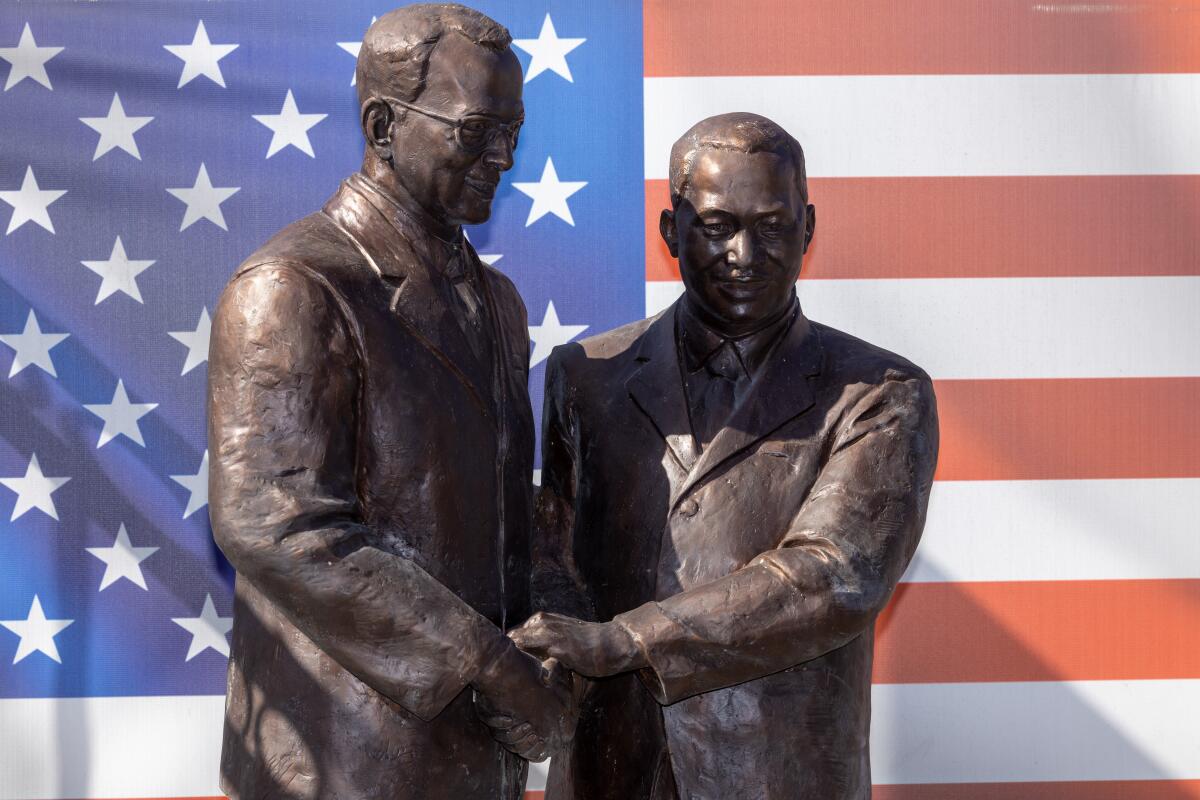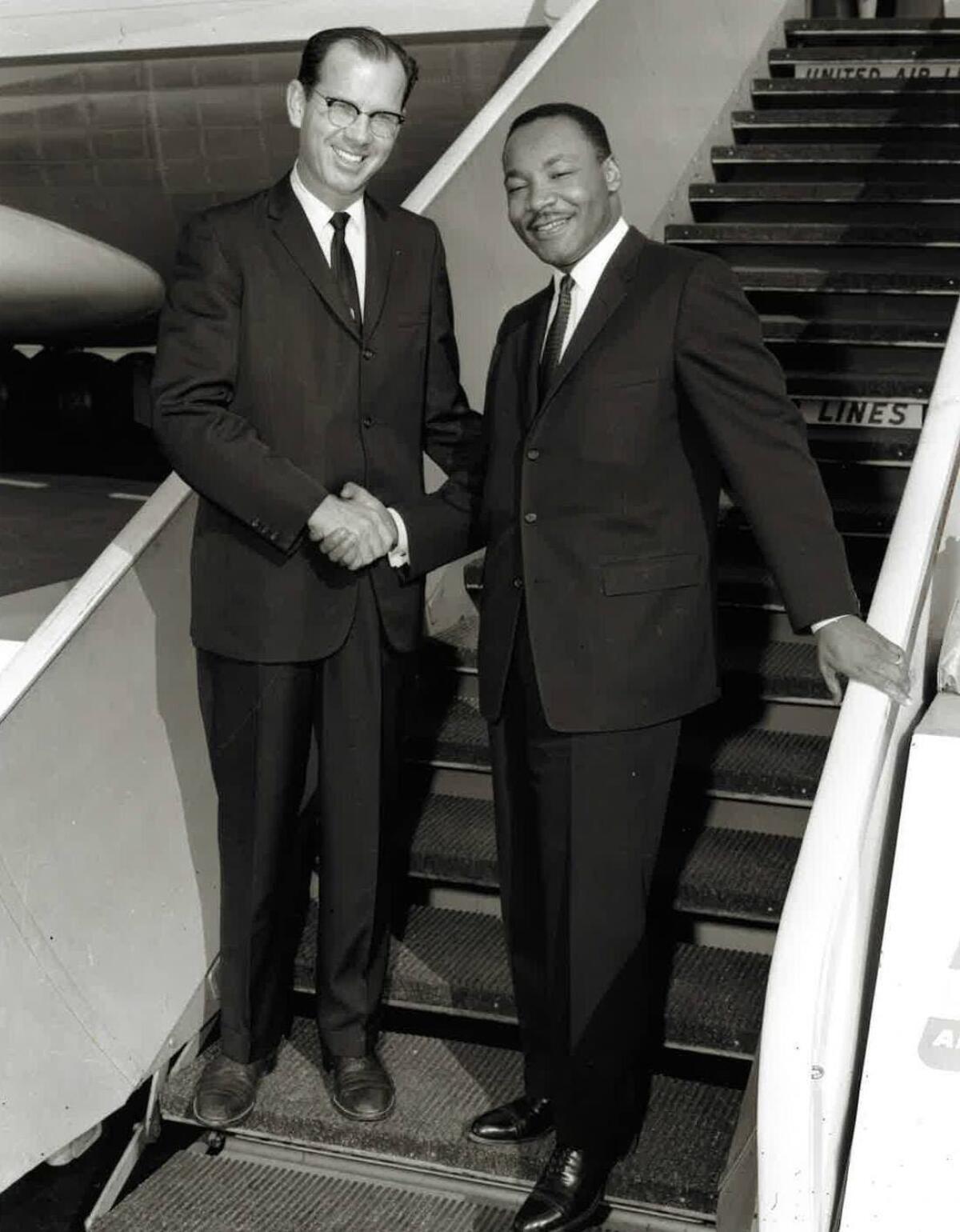When Martin Luther King Jr. came to L.A., only one white politician was willing to greet him

- Share via
The Rev. Fred O. Doty had invited the Rev. Martin Luther King Jr. to speak at his church in January 1961, and he was looking for an official to greet the civil rights leader at the airport.
But the L.A. mayor had an apparent scheduling conflict.
Council members wanted to spend time with their families.
Senators couldn’t be reached. And assembly members were too busy.
So Doty called L.A. County Supervisor Kenneth Hahn.
“I would be honored to greet Dr. King,” Hahn said.
Supervisor Janice Hahn recalled the story Wednesday during the unveiling of a bronze statue memorializing the moment her father shook King’s hand on the steps of a plane at Los Angeles International Airport.
The life-size statue stands near a church on West Alondra Boulevard in Compton, surrounded by plaques honoring other politicians Kenneth Hahn helped ascend to power.

The moment between King and Hahn remains important in the minds of many Black residents in the 2nd District, which Kenneth Hahn represented for 40 years. He was known as a champion of civil rights in the district, local leaders said.
L.J. Guillory, known as Bishop Guillory, commissioned and paid for the statue.
Guillory said that L.A. politicians declined to greet King because they wanted to keep up the facade that California was better than the places in the South where King was marching for justice.
“California did not want the world to know that they were as racist as the South,” Guillory said. “This was the Tinseltown. This was the land of milk and honey.”
Guillory declined to say who the artist was or how much the statue cost, joking that he’d be divorced if his wife heard the number. The couple, he said, donates a lot of money and time in Compton.
The photo was taken on Jan. 13, 1961, when King arrived for a busy weekend of events.
The Jackson Advocate, the oldest Black newspaper in Mississippi, documented King’s visit, noting that Hahn “extended official greetings” at the airport.
At the Ambassador Hotel, King gave “fiery remarks” to journalists about local leaders drawing district boundaries that barred Black voters from fair representation, according to the Advocate.
“Dr. King stated that the ugliness of segregation can be just as harmful in Los Angeles as in Georgia, and it does exist in the North and in the West though it may be a subtle, under-the-table type of segregation” most obvious in housing, government representation and economic situations, the newspaper said.
That weekend, King helped launch the Western Christian Leadership Conference, which aimed to uplift Black people in the West. He collected $1,400 — about $14,600 in today’s money — to aid in his fight in the South, according to the California Eagle, a Black-owned newspaper in L.A.
Doty invited King to speak after members of his church became “concerned about the repeated shameful incidents in the South” and “sought first-hand information about the developing struggle,” according to the Eagle.
King spoke at Doty’s packed church Sunday morning and then that evening at an event that Doty organized at Canoga Park High School on the “future of integration,” the Eagle said. About 100 people flocked to King with questions after his talk.
After King was assassinated in April 1968 in Memphis, Tenn., Hahn called King’s wife, Coretta Scott King, and asked whether L.A. County could name a new hospital in his honor.
“He’s like, ‘Mrs. King, I don’t think you know who I am, but if it’s OK with you, I’d like to name this hospital in Watts after your husband,’” Janice Hahn, who joined the Board of Supervisors in 2016, said Wednesday. “She stopped him and she said, ‘Oh, no, I know who you are, because when my Martin came home, he couldn’t stop talking about the white official that was so kind to him.’”
That hospital, Martin Luther King Jr./Drew Medical Center, opened in 1972. The troubled facility closed in 2007 after efforts to reform it failed and was replaced in 2015 with Martin Luther King Jr. Community Hospital in Willowbrook.
In November, the Willowbrook hospital’s leaders sounded the alarm that it could run out of money because of a failed funding model. Unlike its predecessor, the hospital has received high ratings from regulators.
Hahn said the hospital was the first thing her father fought for as an elected official.
“It was a big fight because the rest of the county didn’t always believe that that part of L.A. County deserved the same things that everybody else had,” she said.
Kenneth Hahn died in 1997 at 77. During his 45 years of public service, he pushed L.A. County to install freeway emergency call boxes, led the development of the county’s paramedic program and helped bring the Dodgers to L.A.
As noted in his Times obituary, Hahn appointed the late Gilbert Lindsay, who later would join the City Council, as his deputy in 1952 — the first Black person to hold such a position in the county.
Janice Hahn said she has thought back to the family story of her father greeting King many times, including when in 2020 she learned about Bruce’s Beach, an oceanfront property in her district that the city of Manhattan Beach had seized from a Black couple in the 1920s.
“I got a lot of criticism — I had friends who thought I’d lost my way,” Hahn said. “But every once in a while, that moment helps shape the decisions that I make too.”
Times researcher Scott Wilson contributed to this report.
More to Read
Sign up for Essential California
The most important California stories and recommendations in your inbox every morning.
You may occasionally receive promotional content from the Los Angeles Times.











